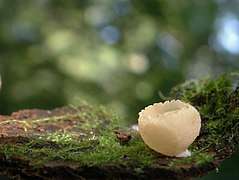Tarzetta cupularis
Tarzetta cupularis is a species of apothecial fungus belonging to the family Pyronemataceae. This is a species of northern Europe with occasional records from further south in Spain and Morocco. It also occurs in North America. It appears from spring to autumn as brown to cream-coloured flask-shaped cups up to 2 cm across and 2.5 cm tall in groups in damp woodland. The related Tarzetta catinus tends to be larger with a more open cup, but the two species can only be reliably distinguished microscopically: by the shape of the spores (those of T. cupularis being narrower) and the paraphyses (those of T. cupularis lacking the distinctive lobed tips of T. catinus). T. cupularis is inedible.[1]
| Tarzetta cupularis | |
|---|---|
 | |
| Scientific classification | |
| Kingdom: | |
| Division: | |
| Class: | |
| Order: | |
| Family: | |
| Genus: | |
| Species: | T. cupularis |
| Binomial name | |
| Tarzetta cupularis (L.) Svrček (1981) | |
| Synonyms | |
| |
References
- Phillips, Roger (2010). Mushrooms and Other Fungi of North America. Buffalo, NY: Firefly Books. p. 364. ISBN 978-1-55407-651-2.
- Jordan, Michael (2004). The Encyclopedia of Fungi of Britain and Europe. Frances Lincoln Publishers. p. 41. ISBN 978-0-7112-2379-0.
This article is issued from Wikipedia. The text is licensed under Creative Commons - Attribution - Sharealike. Additional terms may apply for the media files.